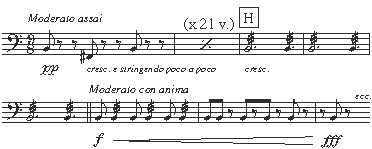|
MEASURED ROLLS ACCORDING TO TCHAIKOVSKY |
|
Before getting into an analysis of the various writings, it seems like a good idea to clarify that with the timpani, in the majority of cases, measured rolls are only such for the one who is playing them. This is because, due to the overlapping of harmonic sounds, what reaches the listener is always a single and continuous note. The only exceptions are, obviously, represented by performances of very acute notes (and thus with skins very tightly stretched) with wooden or very incisive mallets.
Having clarified this hardly trivial detail, let us try to interpret and comment on, from both a theoretical and technical point of view, several of the rolls written in P. I. Tchaikovsky's fourth and fifth symphonies. First of all, it should be mentioned that, unlike Beethoven and Brahms, Tchaikovsky (at least in the symphonies we're dealing with) always uses conventional 32nds to indicate a roll and never the tr sign (reserved only for trills). To tell the truth, in some partitas and some repertory texts, the roll is also indicated with 64ths. At first sight, this could make you think that the composer was using the 32nds to indicate a measured roll and the 64ths to indicate non-measured rolls. But it could also have to do with some “blunder” by one of the first copyists or simply a “bad habit,” because in the practical act, which is to say, from the sound effect, the substance doesn't change. Returning to an analysis of our symphonies, the first point that merits some reflection is at the fourth measure of letter H (nine eighths time Moderato con anima). It has to do with playing a quaver and eight demisemiquavers for each movement (example 1). Inasmuch as you arrive "to Moderato," after a long growing "stringendo," the time is still "vivo" enough to worry an inexperienced player. However, the real problem arises when you repeat the same thing at the fourth measure of letter T in a faster tempo (Allegro con anima). In the orchestra, execution doesn't raise any worries because what counts most is the ensemble. If, however, the “passage” is required for an exam, and you have the misfortune to find a technician who is not a percussionist, but an orchestra conductor who is playing…accountant, it is a good idea to note that, in this case, you are dealing with an unmeasured effect…since it is also true that, in some partitas, the same point is actually marked with 64ths. Still in the same symphony, the long rolls are written with dotted half notes and quarter notes for every measure. It has to do with continuous rolls that are never interrupted (example 1, letter H), even if written separately and without the familiar and useless slurs. In fact, if we really wanted to perform these as measured rolls, i.e., as demisemiquavers, they would have to always be performed without the solution of continuity. The same discussion also applies to the four measures at letter Z in the fifth symphony, where there is a “syncopated” roll effect. Even these short rolls are played “together,” in other words, without interruption; as if there was a value slur between them (second line of example 2). However, don't let our example mislead you with dealing with broken-line slurs. The slur has, rightly, been omitted by the composer because it has to do with semidemiquavers, or measured rolls, and not with other values to be prolonged with slurs. |
Example 1

Example 2
